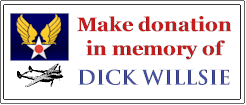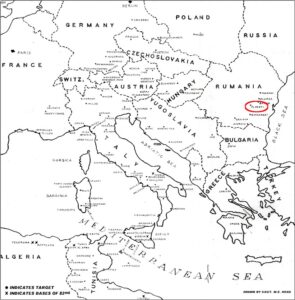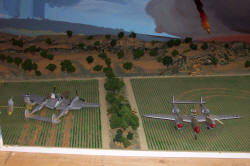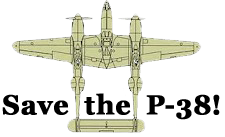Willsie’s Rescue
P-38 National Association
Visit the Museum
Visit the Store
Support Our Mission
Story
Map
Photos
Siltver Star Citation
Vietnam Rescue
If you’d like to donate to the P‑38 Association in memory of Dick Andrews or Dick Willsie, please click the link below.
An Heroic Rescue
On August 4, 1944, the 82nd Fighter Group, based at Foggia, Italy, received a particularly hazardous assignment. It was a “shuttle” mission to Russia, a number of which, codenamed FRANTIC, were flown by the 8th AF in England and the 15th AF in Italy that summer. After completing a mission over Axis Europe the American planes would land in Russia from which they would fly others, returning to their home bases at the end of the last one.
MISSION MAP. Area circled in red is where Dick Willsie crash landed and where Dick Andrews swooped in to rescue him, while both were under enemy fire.
This mission, FRANTIC 4, was to strafe enemy airfields and other ground targets in Romania en route to Poltava, in the Ukraine, its temporary Russian base.
As the group attacked some trains and trucks near Ploesti, anti-aircraft fire knocked out the left engine of the P‑38 flown by 96th Fighter Squadron flight leader Dick Willsie. It was Willsie’s 59th mission and turned out to be his most exciting.
Although now on one engine Lt. Willsie joined in strafing a nearby airfield, where his good engine was also hit by flak. “I noticed coolant streaming from my right engine cooler located aft of the boom. This meant I only had a few minutes left, at best. I then made a call and reported my plight, and that I was going down.” A response came from one of his squadron mates, 20-year-old Flight Officer Dick Andrews, of Portland, Oregon, whose 10th mission this was: “Pick a good field and I will come in after you.”
Willsie, whose hometown was Long Beach, California, recalled later that. “I had to get down quickly if I wanted to have any control of the landing. I forgot about everything else and concentrated on putting the plane down.”
“Suddenly; my windshield cracked from another hit I felt a sting on my head and then a warm trickle down my forehead. I saw a place to land and two quick turns and a sideslip put me in position over some trees and down. As I slid over the last obstacle and touched down, I placed my head against the rubber [padding] on the gun sight-and before the plane skidded to a stop my nose felt like Joe Louis had broken it with several of his left jabs and right hooks! I put my hand up to my face and it came back with thick blood all over it. I felt sick. But I cou1d still move, and move I did! I jumped out on the left wing.”
“I could hear planes overhead and saw some P‑38s and Me‑109s dogfighting. I also saw men in the distance and trucks not far off. I heard rifle fire and the whine of bullets. I headed down the left wing, which was flat against the ground, and turned to run for the cover of the nearby trees.”
Rescue of Downed P‑38 Lightning Pilot
Romanian Rescue Diorama at P-38 Museum
“At this time I saw Andrews’ plane with its landing gear down. Spellbound, I dropped down and watched it. I thought, ‘My God, he is coming in to pick me up!’ The field was soft and had obviously been planted recently, as there was stubble about an inch high. I had on sheepskin flying boots, not the best running gear, but I ran anyway for what seemed like the length of a football field, toward his plane. When he finally stopped. he started to taxi in my direction, but someone called him on the radio and said to stay there, because I was coming to him.”
Andrew’s had watched [Willsie] land across furrows, then made a 180o turn, putting his gear and flaps down. “Seeing I was too close to the field, I picked my gear up, made a 270o turn and started my approach, putting my gear back down when I saw I could make the field. I landed with the furrows, making sure to make a smooth landing. I stopped 100 feet from a cornfield, pulled my flaps up and set them in takeoff position. Leaving the engines running at 1800 rpm, I locked the brakes.”
While this was going on, other 82nd FG pilots were battling the Me‑109s and strafing the enemy troops that were trying to kill or capture the two temporarily grounded flyers.
Willsie: “When I got to Dick’s P‑38 he was standing on the wing. He had dropped the fold-down ladder and thrown his chute away. Although out of breath, I managed a big smile. He grabbed my hand and pulled me up on the wing. He said, ‘You fly,’ and we both jumped into the cockpit with a miracle of precision. I sat as far forward as I could, with him behind me, not really on his lap and he not really on my back. His right leg had to be placed over my right shoulder, because the control column on a P‑38 comes up from the right side of the cockpit. His left leg was down under my left arm. My hind end was on the front part of the bucket seat.”
“We pulled the canopy closed. He put up the right window and I put up the left. This all occurred within seconds. I then pushed the propeller control to low pitch, pulled back on the controls to keep the nose up, and eased the throttles forward. I felt the nose wheel dig into the soft earth of the plowed meadow when I let go of the brakes. I couldn’t get the control wheel back any farther, so I cranked in full trim — nose up. It did come up, and we started rolling. There were trees ahead of us, so I put down the flaps to combat position, which helped us lift off. Now I had to play the climb just enough to clear the trees — not too much or we would mush right into them. We did clear those trees, but I sure was glad they weren’t ten feet taller!”
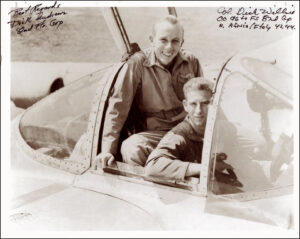
They were, miraculously, in the air and on their way again. There followed an extremely uncomfortable 2½‑hour flight to Poltava in a very cramped cockpit, with a bleeding pilot (Andrews swabbed Willsie’s cuts with iodine). Dick Andrews remembered that “We kept our spirits up by joking about it all and kidding each other. We landed at the Russian base ahead of the other planes, due to Willsie’s expert piloting. Those crew chiefs really flipped when they saw [both of] us climbing out of that P‑38!”
When you look at the picture above you realize just how very young these two men were during this dramatic rescue operation!
A Safe Return
When they returned to Foggia, Italy, two days later, the two Lightning pilots were treated like celebrities. After they landed they were immediately met by several VIPs, including Generals Nathan Twining, the C.O. of the 15th Air Force, and Dean Strother, the 306th Fighter Wing Commander. As Andrews stepped out of his plane he was greeted by Gen. Twining, who gave him a spot promotion to second lieutenant and awarded him the Silver Star! A few days later he received a special commendation from Gen. Ira Eaker, C.O., U.S. Strategic Air Forces in Europe. The two men subsequently completed their combat tours with the 82nd FG.
Richard Andrews and Richard Willsie continued to fly combat missions. Andrews with his Silver Star became a First Lt. and a 96th FS Flight Leader, and Willsie became a Major and a Commander of the 96th FS and Group Leader.
Both of them had distinguished post‑war USAF careers. Andrews passed away on November 7, 2007 and Willsie on Feb. 16, 2013.
POSTSCRIPT
In recent years, more and more of Dick Andrews’ friends (and many others who have read about his exploit) have come to believe that he should have been awarded a higher decoration — specifically, the Medal of Honor — as was Skyraider pilot Bernie Fisher in Vietnam for performing a very similar feat.
The members of the P‑38 Association began a written campaign and petition to have Dick Andrews medal upgraded. After Dick passed away his family requested that we dicontinue our efforts in this regard.
We strongly believe what he did was extraordinary and well worth the medal upgrade, but are honoring the wishes of his family.
Another Historic Rescue Based on the Romanian Rescue of Willsie
One morning a U.S. Army camp situated far north of any other military camps, was surrounded by North Vietnam soldiers. The two Air Commando Squadrons were making an all-out effort to save this Camp.
Major Dafford Myers of the 602nd was on a mission to help that camp from being wiped out. He unluckily got hit by ground f1re. He decided to land on the camp’s short runway, even though it was within the range of the ordinance of the enemy’s fire power.
Myers called out that he was going to land on the runway. Luckily, Bernard Fisher saw what happened and said to himself, “If Dick Andrews in WWII could go down and pick up Willsie, I’m going down to pick up Myers.”
He did, and when he pulled up next to Myers plane Myers jumped into Fisher’s airplane — luckily the AIE Skyraider had two seats side by side. They did get hit by rifle fire, but fortunately there was no serious damage to the plane. The cloud cover was very low, so they were quickly into the clouds and out of danger.
Shortly after that they were back at their friendly airport with no damage to the pilots at all. As a result of this rescue, Bernie Fisher received the Medal of Honor.
POSTSCRIPT
It seems to us to be a “no brainer” that Dick Andrews should have been awarded the Medal of Honor for the rescue of Dick Willsie that he performed in his P‑38 — which was the inspiration for Fisher’s heroic rescue of Myers. Read Andrews story.
Important Notice
Although we are housed on the grounds of the March Air Museum, the P‑38 Association’s Museum is a separate and independent non-profit organization.
We are not affiliated with the USAF or Lockheed, and our entire operation is supported solely by people like you. See how you can help us with our mission!
Non-Profit StatusThe P-38 National Assn is a 501(c)(19) non-profit, tax–exempt veteran’s organization.


